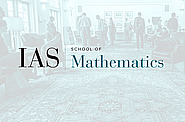2004-2005 seminars
Mar
22
2005
Computer Science/Discrete Mathematics Seminar II
1 Dimensional Diffusion Limited Aggregation (DLA)
Gideon Amir
10:30am|S-101
Mar
21
2005
Computer Science/Discrete Mathematics Seminar I
Network Games and the Price of Stability or Anarchy
Eva Tardos
11:15am|S-101
Mar
15
2005
Mar
14
2005
Mar
08
2005
Mar
07
2005
Computer Science/Discrete Mathematics Seminar I
Graph Homomorphisms, Statistical Physics, and Limits of Graph Sequences
11:15am|S-101
Mar
01
2005
Computer Science/Discrete Mathematics Seminar II
Pseudorandom Walks in Biregular Graphs and the RL vs. L. Problem
10:30am|S-101
Feb
28
2005
Feb
22
2005
Computer Science/Discrete Mathematics Seminar II
Quadratic Forms on Graphs
Konstantin Makarychev
10:30am|S-101
Feb
21
2005
